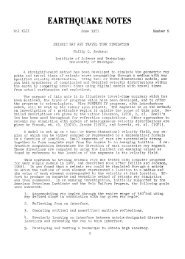OPINION - Seismological Research Letters
OPINION - Seismological Research Letters
OPINION - Seismological Research Letters
- No tags were found...
Create successful ePaper yourself
Turn your PDF publications into a flip-book with our unique Google optimized e-Paper software.
OpinionO PINIO NA Warning about Early WarningInterest in the concept of “early warning” for earthquakes isincreasing rapidly. The Japanese announced their version ofa public system last fall. In the United States, algorithms arebeing developed and tests formulated to assess earthquake earlywarning systems in order to determine their relative merits andhelp improve their speed and reliability. At last fall’s AmericanGeophysical Union (AGU) meeting therewere no fewer than 40 papers devotedto technical aspects of earthquake earlywarning. The simple concept of detectinga large earthquake soon enough after itsorigin to warn distant communities beforestrong shaking begins is easy to grasp. Forthe most part the basic scientific knowledgeexists, and the technology to implementit is rapidly becoming a reality. But isthe breakneck speed at which the technologyis developing going to outstrip its realusefulness in a complex, multidimensionalworld?Earthquake early warning is not thefirst type of early warning to be used fornatural hazards. It might be instructive to examine the trackrecords for other early warning systems to help anticipateproblems in their future use for earthquakes. Of course, thedifference between prediction and early warning is very clearfor earthquakes, but for slowly developing hazards such as hurricanesthese grade into one another. For our purposes, oncean event is underway, early warning in order to mitigate consequencesis the relevant technology.Unfortunately the success of prediction technology isinversely proportional to the speed of the damaging elements.Forecasters can warn us about storms more than a week inadvance, yet they move only at cm/sec. We usually can anticipatevolcanic eruptions hours to days ahead, and their eruptiveproducts (ash clouds or lahars) move at meters/sec. But seismicwaves travel at km/sec, and their source—earthquakes—are notpredictable at all.The successes of meteorological early warnings are wellknown—fromtornadoes to hurricanes to major blizzards andfloods. The technology is mature and the science well-advanced.The linkages between the warning technology and its practicalapplication by civil authorities and the public are usually wellestablishedand effective. We experience weather every day andBetter escape routes anda seismologically basedearly warning system werechosen as more politicallyacceptable alternatives.Unfortunately, with theseoptions in place and noeffective zoning for futureland use, developers sawthe now “protected,” flat,500-year-old lahar depositsas easy and cheap buildingsites for subdivisions.are used to predictions and warnings related to it. Even so thereare notable failures of the application of meteorologic earlywarning for the biggest events. The early warning for HurricaneKatrina was remarkably detailed and accurate and was availabledays ahead, and yet both local and national reaction to thewarnings was very poor. The resulting disaster had nothing todo with the quality or timeliness of the early warning and everythingto do with its interpretation and use by the civil authorities.Less familiar to most people is volcanoearly warning. While volcanicunrest allows for crude predictions of thepotential for imminent eruptions, oncean explosion takes place there is little timebefore ash can impact air traffic corridors.After near disasters from aircraft flyinginto volcanic ash clouds in the 1980s(for example, in 1989 a 747 lost powerin all engines for five minutes while onapproach to Anchorage, Alaska, due toash from Mount Redoubt), an internationalcollaboration between volcanoobservatories and meteorological agenciesnow routinely generates both predictionsand early warnings for ash. The number of aircraft-ash encountersin recent years has been very few (average of three per yearversus eight per year in the 1980s and early 1990s), and thesehave been minor with no serious consequences. The success ofthis little-known early warning system may be leading to its degradation.Funding for the U.S. Geological Survey (USGS) partof this system was greatly reduced last year. The specific reasonslie buried in the intricacies of politics, but one can’t help butwonder if the lack of recent ash-induced air disasters reduces itsfunding needs from a politician’s point of view.Another sort of volcano early warning that has been implementedin the United States is for lahars (volcanic mud flows)from Mount Rainier. However, I have serious reservationsabout the appropriateness of its use in this case. The realizationin the 1980s that the town of Orting, Washington, was in avery precarious position in the direct path of likely lahars fromMount Rainier spurred a hazard mitigation effort. While landuse planning was an obvious and effective solution to the problem,moving the 3,000-person village out of the valley, or evenlimiting further growth, was not considered a viable option.Better escape routes and a seismologically based early warningsystem were chosen as more politically acceptable alternatives.doi: 10.1785/gssrl.79.5.603<strong>Seismological</strong> <strong>Research</strong> <strong>Letters</strong> Volume 79, Number 5 September/October 2008 603
Unfortunately, with these options in place and no effective zoningfor future land use, developers saw the now “protected,” flat,500-year-old lahar deposits as easy and cheap building sites forsubdivisions. The town has more than doubled in size since thewarning system was proposed. Even if the warning system actuallyworks, it is unlikely that most of this larger population couldbe safely evacuated in the 30–45 minutes before a lahar reachesthe town from the volcano. Thus, the technology-only solutionmay end up killing more people than if it were not available andif limiting growth were seen as the reasonable thing to do. Ifan inexpensive solution is perceived at the policy-maker levelto provide adequate warning to save lives, other more effectivemitigation may not be considered.A case somewhat similar to an earthquakeearly warning is that for a tsunami.The damaging waves of a tsunami travelmuch more slowly than those for earthquakes,providing more time to evacuatehazardous locations. It stands to reasonthat the disaster of the 2004 Indian Oceantsunami could have been greatly reduced bya tsunami warning system for the region;however, without good communicationsand education of the coastal people onhow to react to a warning, a warning systemalone might not have made much difference. Even in theUnited States where the communications infrastructure is verygood and education levels are high, I have concerns about howeffective our recently upgraded tsunami warning system reallyis. The public response to the M 7.2 earthquake off the coastof northern California in June 2005 provides a case in point.Technologically the early warning for this possible tsunami wasnearly perfect. The warning was very timely (four minutes followingearthquake origin time), but the immediate responsewas hugely variable. In the few “tsunami ready” towns wheretraining, signing, and good plans had been made, more than90% of those in potential inundation areas were properly evacuated.However, for most of the warning area the response variedfrom doing very little (even when the warnings were received)to not getting the warnings due to communications glitches.There was confusion over the meaning of the warning messagesas well as ignorance of what to do on the part of emergencyresponders, the media, and the public.Following the Indian Ocean tsunami disaster, Congressappropriated more than $30 million to upgrade our warningsystems: most of it went to technological additions (oceanbuoys and seismographs). I am told that much of the smallamount designated for local-level education, communication,and coastal preparedness still is not available to the end user.My point in detailing the problems with other early warningsystems is to emphasize that the science and technology partsof such systems seem to be way ahead of their effective application.Serious work is needed in the political and social sciences,education, and emergency management parts of the systems toMy point in detailingthe problems with otherearly warning systemsis to emphasize that thescience and technologyparts of such systemsseem to be way ahead oftheir effective application.realize the potential of early warning technology. As dedicatedscientists, we are quick to advocate for more research and developmentto improve the speed and accuracy of warnings. But asresponsible citizens should we not also strongly advocate for therest of the system? Perhaps in some cases technology should notbe the central focus. If so, we should be honest about its relativeimportance and encourage or advocate for a more comprehensivesolution. However, we must be careful in taking this path,for once we step across the line to political advocacy, particularlyoutside our areas of expertise (zoning, for example), our objectivityas scientists to provide unbiased scientific information andadvice is compromised. At the same time, when common sensesays that a technological solution alone is not the answer, it isour responsibility as citizens to call publicofficials’ attention to what may be a wastefulapproach at best and, at worst, mightlead to an increasingly dangerous situation.The United Nations International Strategyfor Disaster Reduction report, Living withRisk: A Global Review of Disaster ReductionInitiatives (2004 version), recognizes thecritical role of science and technology;however the report warns that “an overconcentration on technical abilities at theexpense of the human aspects … will providedisappointing results. In particular circumstances, scienceand technology can be misapplied, sometimes provoking oraggravating risks to a society.”Regarding earthquake early warning, while research intothe technology is a worthy pursuit, I am increasingly concernedthat its marketing to the public is disingenuous. Will the extrafew seconds that another $20 million worth of seismograph stationsin California might provide to some people for some typesof earthquakes really make things better? Can we really say thatseconds or even tens of seconds of warning will be useful whenhours to days of warning for Katrina and other hazards seem tohave been so ineffective? Perhaps the Japanese experiment willhelp to answer some of these questions, but will those answersbe applicable to the very different political and social environmentin the United States?As the development of early warning technology forearthquakes continues, we must take into account the largerpicture. Indeed, the Scientific Earthquake Studies AdvisoryCommittee’s 2007 annual report to the USGS director recommendsthat a “feasibility of earthquake alerting in the UnitedStates must include carrying out a comprehensive assessment ofhow such information would be used by end-users.” We muststep outside our ivory tower and try to anticipate the larger consequencesof our developing tools and make sure that they willactually improve earthquake hazard reduction.Steve MaloneUniversity of Washingtonsteve@ess.washington.edu604 <strong>Seismological</strong> <strong>Research</strong> <strong>Letters</strong> Volume 79, Number 5 September/October 2008
















